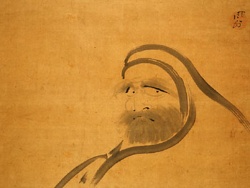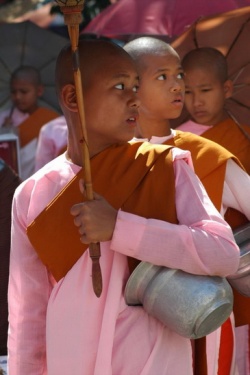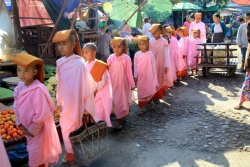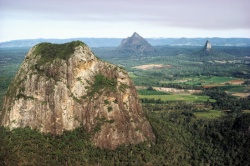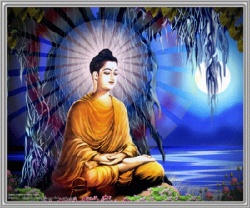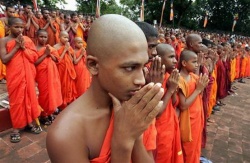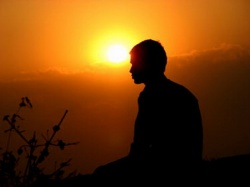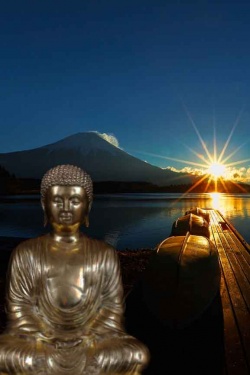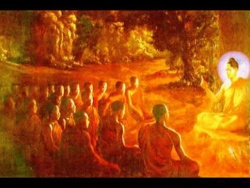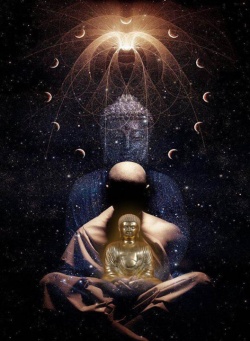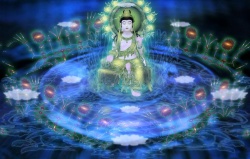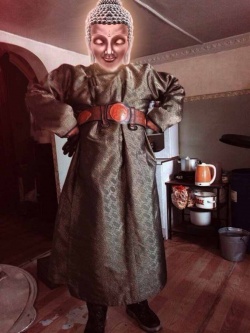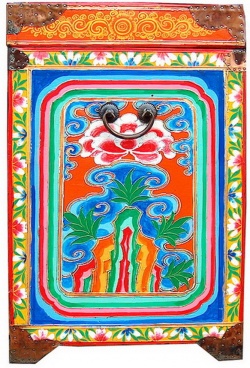Ordination of women in Buddhism
The ordination of women in Buddhism is and has always been practiced in some Buddhist regions, such as East Asia, is being revived in some countries such as Sri Lanka, and is newly beginning in some Western countries to which Buddhism has recently spread, such as the United States.
Ordained monastic community
The tradition of the ordained monastic community (sangha) began with the Buddha, who established an order of Bhikkhus (monks). According to the scriptures, later, after an initial reluctance, he also established an order of Bhikkhunis (nuns or women monks).
However, according to the scriptural account, not only did the Buddha lay down more rules of discipline for the bhikkhunis (311 compared to the bhikkhu's 227 in the Theravada version), he also made it more difficult for them to be ordained, and made them subordinate to monks.
According to Peter Harvey, "The Buddha's apparent hesitation on this matter is reminiscent of his hesitation on whether to teach at all", something he only does after persuasion from various devas.
Since the special rules for female monastics were given by the founder of Buddhism they have been upheld to this day.
Buddhists nowadays are still concerned with that fact, as shows at an International Congress on Buddhist Women's Role in the Sangha held at the University of Hamburg, Germany, in 2007.
Historicity of the account
The historicity of this account has been questioned, sometimes to the extent of regarding nuns as a later invention. The stories, sayings and deeds of a substantial number of the preeminent Bhikkhuni disciples of the Buddha as well as numerous distinguished bhikkhunis of early Buddhism are recorded in many places in the Pali Canon,
most notably in the Therigatha and Theri Apadana as well as the Anguttara Nikaya and Bhikkhuni Samyutta.
Additionally the ancient bhikkhunis feature in the Sanskrit Avadana texts and the first Sri Lankan Buddhist historical chronicle, the Dipavamsa, itself speculated to be authored by the Sri Lankan Bhikkhuni Sangha.
Tradition in South and East Asia
The tradition flourished for centuries throughout South and East Asia, but appears to have lapsed in the Theravada tradition of Sri Lanka in the 11th century C.E.
It survived in Burma to about the 13th century, but died out there too. Although it is commonly said to have never been introduced to Thailand, Laos, Cambodia or Tibet, there is substantial historical evidence to the contrary, especially in Thailand.
However, the Mahayana tradition, in China, Korea, Vietnam, Taiwan and Hong Kong, has retained the practice, where nuns are called 'Bhikṣuṇī' (the Sanskrit equivalent of the Pali 'Bhikkhuni').
In 13th century Japan, Mugai Nyodai was ordained the first female abbess and thus the first female Zen master. Prajñādhara is the twenty-seventh Indian Patriarch of Zen Buddhism and is believed to have been a woman
.
Recent developments
America
In 1997 Dhamma Cetiya Vihara in Boston was founded by Ven. Gotami of Thailand, then a 10 precept nun. Ven. Gotami received full ordination in 2000, at which time her dwelling became America's first Theravada Buddhist bhikkhuni vihara.
"Vihara" translates as monastery or nunnery, and may be both dwelling and community center where one or more bhikkhus or bhikkhunis offer teachings on Buddhist scriptures, conduct traditional ceremonies, teach meditation, offer counseling and other community services, receive alms, and reside.
In 2003 Ven. Sudhamma Bhikkhuni took the role of resident female-monk at the Carolina Buddhist Vihara in Greenville, SC (founded originally by Sri Lankan monks in 2000); her new dwelling thus became the second such community-oriented bhikkhuni vihara in America.
The third such residence, Dhammadharini Vihara, now known as the Bodhi House was founded in Fremont, CA, by Ven. Tathaaloka of the USA, in 2005. Soon afterwards, Samadhi Meditation Center in Pinellas Park, Florida, was founded by Ven. Sudarshana Bhikkhuni of Sri Lanka.
More recently established Theravada bhikkhuni viharas include:
Mahapajapati Monastery where several nuns (bhikkhunis and novices) live together in the desert of southern California near Joshua Tree, founded by Ven. Gunasari Bhikkhuni of Burma in 2008;
Aranya Bodhi Hermitage founded by Ven. Tathaaloka Bhikkhuni in the forest near Jenner, CA, with Ven. Sobhana Bhikkhuni as Prioress, which opened officially in July 2010, where several bhikkhunis reside together along with trainees and lay supporters;
and Sati Saraniya in Ontario, founded by Ven. Medhanandi in appx 2009, where two bhikkhunis reside.
(There are also quiet residences of individual bhikkhunis where they may receive visitors and give teachings, such as the residence of Ven. Amma Thanasanti Bhikkhuni in 2009-2010 in Colorado Springs; and the Los Angeles residence of Ven. Susila Bhikkhuni; and the residence of Ven. Wimala Bhikkhuni in the mid-west.)
In 2010 the first Tibetan Buddhist nunnery in North America was established in Vermont, called Vajra Dakini Nunnery, offering novice ordination.
The abbot of this nunnery is an American woman named Khenmo Drolma who is the first "bhikkhunni," a fully ordained Buddhist nun, in the Drikung Kagyu tradition of Buddhism, having been ordained in Taiwan in 2002.
She is also the first westerner, male or female, to be installed as a Buddhist abbot, having been installed as abbot of Vajra Dakini Nunnery in 2004.
Also in 2010, in Northern California, 4 novice nuns were given the full bhikkhuni ordination in the Thai Theravada tradition, which included the double ordination ceremony. Bhante Gunaratana and other monks and nuns were in attendance. It was the first such ordination ever in the Western hemisphere.
The following month, more bhikkhuni ordinations were completed in Southern California, led by Walpola Piyananda and other monks and nuns.
The bhikkhunis ordained in Southern California were Lakshapathiye Samadhi (born in Sri Lanka), Cariyapanna, Susila, Sammasati (all three born in Vietnam), and Uttamanyana (born in Myanmar).
Australia
In 2009 in Australia four women received bhikkhuni ordination as Theravada nuns, the first time such ordination had occurred in Australia. It was performed in Perth, Australia, on 22 October 2009 at Bodhinyana Monastery.
Abbess Vayama together with Venerables Nirodha, Seri, and Hasapanna were ordained as Bhikkhunis by a dual Sangha act of Bhikkhus and Bhikkhunis in full accordance with the Pali Vinaya.
Burma
The governing council of Burmese Buddhism has ruled that there can be no valid ordination of women in modern times, though some Burmese monks disagree.
Germany
The International Congress on Buddhist Women's Role in the Sangha: Bhikshuni Vinaya and Ordination Lineages took place in Germany, in July 18–20, 2007.
The first bhikkhuni ordination in Germany, the ordination of German nun Samaneri Dhira, occurred on June 21, 2015 at Anenja Vihara.
Indonesia
The first Theravada ordination of bhikkhunis in Indonesia after more than a thousand years occurred in 2015 at Wisma Kusalayani in Lembang, Bandung.
Those ordained included Vajiradevi Sadhika Bhikkhuni from Indonesia, Medha Bhikkhuni from Sri Lanka, Anula Bhikkhuni from Japan, Santasukha Santamana Bhikkhuni from Vietnam, Sukhi Bhikkhuni and Sumangala Bhikkhuni from Malaysia, and Jenti Bhikkhuni from Australia.
Sri Lanka
There have been some attempts in recent years to revive the tradition of women in the sangha within Theravada Buddhism in Thailand, India and Sri Lanka, with many women ordained in Sri Lanka since 1996. In 1996 through the efforts of Sakyadhita, an International Buddhist Women Association,
Theravada bhikkhuni order was revived, when 11 Sri Lankan women received full ordination in Sarnath, India, in a procedure held by Ven. Dodangoda Revata Mahāthera and the late Ven. [[Mapalagama Vipulasāra[[ Mahāthera of the Mahābodhi Society in India with assistance from monks and nuns of Korean Chogyo order.
Some bhikkhuni ordinations were carried out with the assistance of nuns from the East Asian tradition; others were carried out by the Theravada monk's Order alone. Since 2005, many ordination ceremonies for women have been organized by the head of the Dambulla chapter of the Siyam Nikaya in Sri Lanka.
Thailand
In 1928, the Supreme Patriarch of Thailand, responding to the attempted ordination of two women, issued an edict that monks must not ordain women as samaneris (novices), sikkhamanas (probationers) or bhikkhunis.
The two women were reportedly arrested and jailed briefly. Varanggana Vanavichayen became the first female monk to be ordained in Thailand in 2002.
Dhammananda Bhikkhuni, previously a professor of Buddhist philosophy known as Dr Chatsumarn Kabilsingh, was controversially ordained as first a novice and then a bhikkhuni in Sri Lanka in 2003 upon the revival of the full ordination of women there.
Since then, the Thai Senate has reviewed and revoked the secular law banning women's full ordination in Buddhism as unconstitutional for being counter laws protecting freedom of religion.
More than 20 further Thai women have followed in Dhammananda Bhikkhuni's footsteps, with temples, monasteries and meditations centers led by Thai bhikkhunis emerging in Samut Sakhon, Chiang Mai and Rayong.
the Thai Senate has reviewed and revoked the secular law passed in 1928 banning women's full ordination in Buddhism as unconstitutional for being counter to laws protecting freedom of religion.
The stance of the Thai Sangha hierarchy has largely changed from one of denial of the existence of bhikkhunis to one of acceptance of bhikkhunis as of foreign (non-Thai) traditions.
However Thailand's two main Theravada Buddhist orders, the Mahanikaya and Dhammayutika Nikaya, have yet to officially accept fully ordained women into their ranks. Despite substantial and growing support inside the religious hierarchy, sometimes fierce opposition to the ordination of women within the sangha remains.
Tibetan tradition
When Buddhism traveled from India to Tibet, apparently the quorum of twelve fully ordained nuns required for bestowing full ordination never reached Tibet.
There are singular accounts of fully ordained Tibetan women, such as the Samding Dorje Phagmo (1422-1455), who was once ranked the highest female master in Tibet, but very little is known about the exact circumstances of their ordination.
The Dalai Lama has authorized followers of the Tibetan tradition to be ordained as nuns in traditions that have such ordination.
According to Thubten Chodron, the current Dalai Lama has said on this issue:
In 2005, the Dalai Lama repeatedly spoke about the bhikshuni ordination in public gatherings. In Dharamsala, he encouraged, "We need to bring this to a conclusion.
We Tibetans alone can't decide this. Rather, it should be decided in collaboration with Buddhists from all over the world. Speaking in general terms, were the Buddha to come to this 21st century world, I feel that most likely, seeing the actual situation in the world now, he might change the rules somewhat...."
Later, in Zurich during a 2005 conference of Tibetan Buddhist Centers, His Holiness said, "Now I think the time has come; we should start a working group or committee" to meet with monks from other Buddhist traditions. Looking at the German bhikshuni, Ven. Jampa Tsedroen, he instructed,
"I prefer that Western Buddhist nuns carry out this work…Go to different places for further research and discuss with senior monks (from various Buddhist countries). I think, first, senior bhikshunis need to correct the monks' way of thinking.
"This is the 21st century. Everywhere we are talking about equality….Basically Buddhism needs equality.
There are some really minor things to remember as a Buddhist--a bhikshu always goes first, then a bhikshuni….The key thing is the restoration of the bhikshuni vow."
Alexander Berzin referred to the Dalai Lama having said on occasion of the 2007 Hamburg congress
“ Sometimes in religion there has been an emphasis on male importance. In Buddhism, however, the highest vows, namely the bhikshu and bhikshuni ones, are equal and entail the same rights.
This is the case despite the fact that in some ritual areas, due to social custom, bhikshus go first.
But Buddha gave the basic rights equally to both sangha groups. There is no point in discussing whether or not to revive the bhikshuni ordination; the question is merely how to do so properly within the context of the Vinaya. ”
Ogyen Trinley Dorje, the 17th Karmapa, has announced plan to restore nuns’ ordination.
“ No matter how others see it, I feel this is something necessary. In order to uphold the Buddhist teachings it is necessary to have the fourfold community (fully ordained monks (gelongs), fully ordained nuns (gelongmas), and both male and female lay precept holders).
As the Buddha said, the fourfold community are the four pillars of the Buddhist teachings. This is the reason why I’m taking interest in this.

